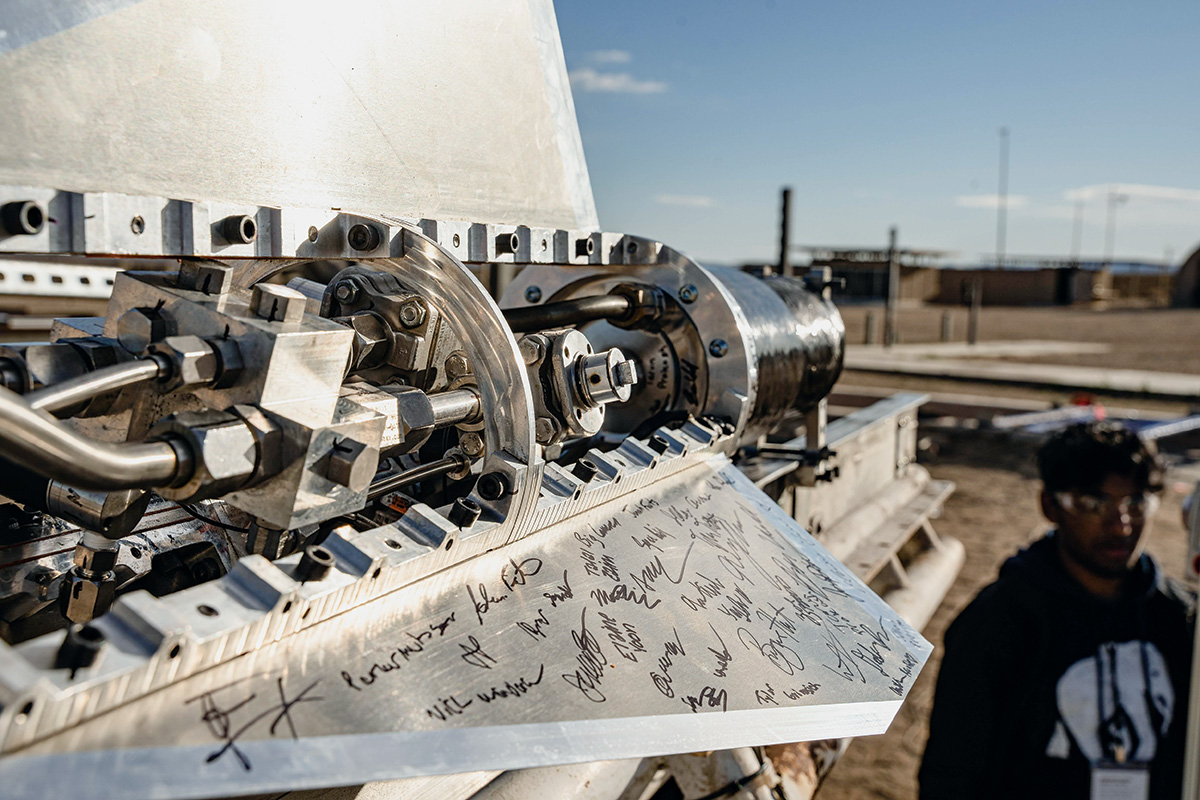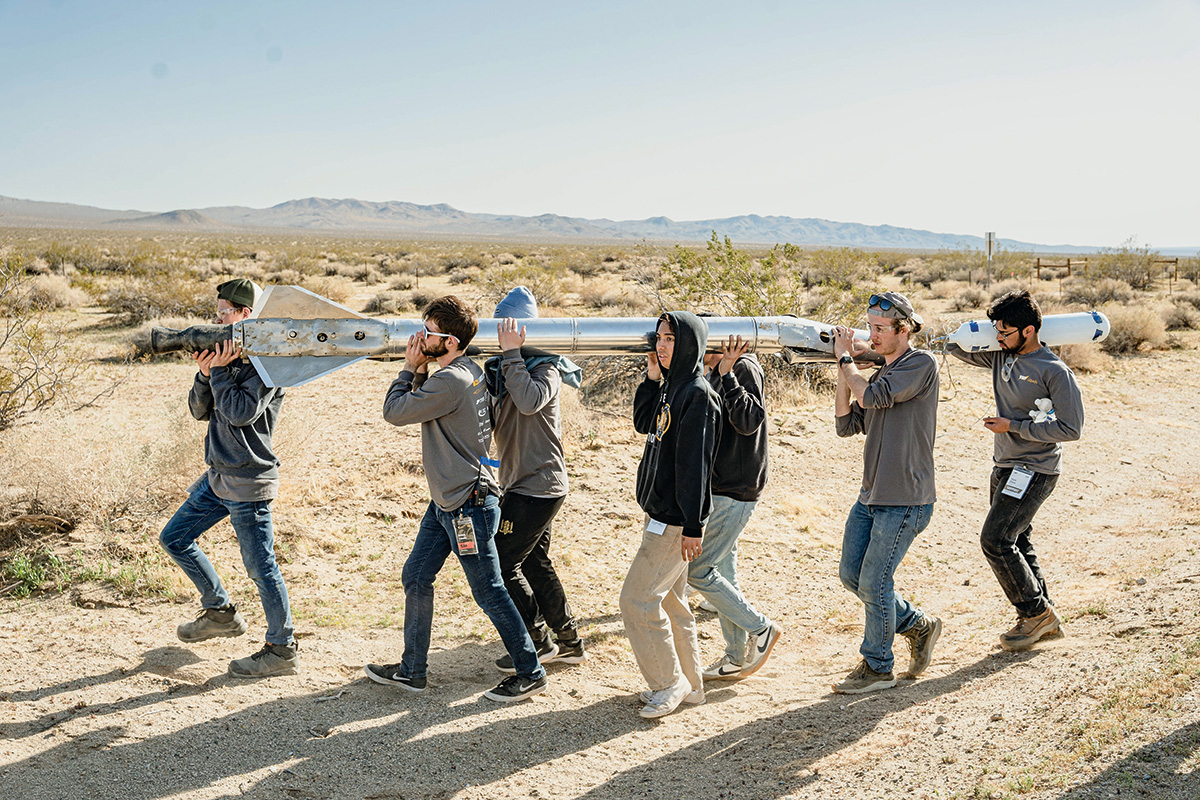
On their way to the FAR-Mars rocket launch competition, a group of Purdue undergraduate engineering students hoped they would make history.
And they would. Just not in the way they thought.
As a culmination of three years of work, the team would take a six-day trip to launch, fail, launch again, fail again — and still earn a distinction previously held only by large aerospace organizations. The Purdue Space Program (PSP) was the first-ever collegiate team to launch the same liquid-fueled rocket more than once.
They did so in just 24 hours, in the middle of the Mojave Desert, without having expected a second launch. And they returned to launch it still a third time 30 days later.
"Solid rocket fuels are pretty simple and well-known, but very few college teams attempt liquid-fueled rockets," says Chris Nilsen, advisor for PSP and a propulsion design, build, test engineer for aeronautics and astronautics. "There are valves, there are pressurizations, and everything has to be kept very cold. There’s a lot of plumbing to figure out."
As a student, Nilsen (BSMDE ’19) fired up PSP’s first attempt at a liquid-fueled rocket, named Boomie Zoomie. They completed several hot fires and launched a subscale solid-fuel version of the rocket — but even though Boomie Zoomie ultimately never flew, their efforts helped draw students who love rocket propulsion to the School of Aeronautics and Astronautics.
PSP — Purdue’s chapter of Students for the Exploration and Development of Space (SEDS) — has grown to more than 400 members and become one of the largest clubs on campus.

Signatures on the Rocket
In May 2022, Nilsen was driving with PSP’s liquids team to the Mojave Desert to see if their rocket — the second iteration of the one he built — would fly. Naturally, the students named it Boomie Zoomie B (BZB).
For BZB, winning the FAR-Mars Society Launch Contest was the goal the whole time. This ongoing competition, held by Friends of Amateur Rocketry (FAR) and the Mars Society, challenges collegiate teams to build and launch a bipropellant liquid-fueled rocket to between 30,000 and 45,000 feet. The Purdue team was hoping to nab the win and the as-yetunclaimed $100,000 prize — which included a cash bonus for using liquid methane specifically.

Will Ipsen (BSAAE ’22), chief engineer on BZB, said the previous team’s many tests confirmed that the first Boomie Zoomie wouldn’t reach the expected altitude. They decided to take the lessons learned from it and build something better.
They got to work, but also had to cope with the COVID-19 pandemic in the middle of their design phase.
"Collaboration is one of the strongest things we do as a team. When we have a design meeting, we go up to a whiteboard, start drawing designs, and then five other people start grabbing markers to show what they think about some part," says Braden Grossfeld (BSAAE ’22), the propulsion lead for BZB. "We couldn’t do that over Zoom. But all our stuff is online, so we were still able to just keep trucking through it."

Once they were able to meet in person again and actually construct the rocket, the team worked tirelessly for many hours per week, enduring Indiana’s brutal winters to continue running tests at Maurice J. Zucrow Laboratories. When chasing leaks, they sometimes found the bottle of soapy water frozen solid.
"This is all undergraduates, and they built it all themselves," Nilsen says. "They got the machine shop to extend its hours, students were machining things day and night."
They also spent huge amounts of time in testing. "The testing is what sets us apart. In fall [2021], we did 13 cold flow tests to prepare for a hot fire. By the time we’re out in the desert, everyone knows what they’re doing by heart," Grossfeld says.

That preparation paid off when the time came to build the launch platform and assemble their Black Cat Launch System (BCLS). The BCLS handles rocket fueling and other controls through more than 50 valves and sensors, mounted on a platform just 4 by 4 feet.
"In Mojave, there were 40 mph winds, plenty of sand, hardly any internet, hardly any electricity, and it was pretty hot. I volunteer with student rocket things all the time, and when you get out to the field, it typically takes a day and a half to get a launchpad set up." Nilsen says. "But these undergrads, they all had a job and they were all super motivated. In a matter of eight hours, they basically built a mobile Zucrow test stand and were ready to go."

Launch day came and setup went smoothly, and though cloud cover threatened, a break in the sky gave them their chance. They set the sequence and the rocket was off, the team shouting and cheering their years of work.
But as their GPS-based ground system began announcing the rocket’s altitude, they could tell something was wrong.
"It calls out 4,000, then 6,000, then 7,000. You can hear that it starts slow down," says Maor Gozalzani (BSAAE ’22), who was launch operations lead on BZB. "One second you’re screaming your heads off with excitement, and then you hear the altitude leveling off. When it eventually calls out 9,000 and then parachute deployment, we’re wondering what the hell’s going on.
"We have the recording, and it’s something that I think none of us can listen to."
Boomie Zoomie B had reached an apogee of just 9,907 feet. The recovery crew found the rocket in good shape, but in their rush to chase it, had forgotten the gear to strap it to the truck. They carried it on their shoulders the two miles back to the launchpad.

Over the next 24 hours, their Boilermaker grit would endure. Knowing they didn’t bring enough fuel for two full launches, they diagnosed the problem and made a contingency plan.
"The rocket was intact, but it landed at 40 feet per second. There was sand everywhere, and we would have to replace all the single-use seals," Grossfeld says. "But we thought we could launch it again.

The problem limiting their launch was obvious: The run valves didn’t fully open before the vehicle took off, essentially running the rocket at half-throttle.
"We had two external actuators, these big bulky things, and they turn those valves 90 degrees to open them. The design is that the actuators hold the rocket, and as it turns the valves vertical, the rocket slips out and launches. On the ground during a hot fire, the rocket doesn’t move, so everything seemed fine," Grossfeld says.
"What actually happened is that the engine starts up so fast — this is in like 50 milliseconds — that the run valves start opening, the fluid gets through, the engine starts up and the rocket is gone just as the valves reach 45 degrees."

When Boomie Zoomie B didn’t reach the target height, the team improvised a fix to the slow valve actuators. Their work resulted in the first-ever collegiate relaunch of a liquid-fueled rocket.
They spent nearly all night rebuilding the rocket and implementing their fix to open the valves faster. Running on barely two hours’ sleep, the team got BZB up on the launchpad again the next morning, filled with all the fuel they had left — about half a tank’s worth.
Their second launch reached 6,700 feet.

The PSP team decided, though most of them were graduating that spring, that they’d rebuild BZB — again. They hoped to return to Mojave in just a month, to fly in FAR’s "Dollar Per Foot" competition for liquid-fueled rockets. It pays out a one dollar per foot of altitude reached.
Their in-the-field fix hadn’t been quite enough to fully open the valves on the second launch, so team developed a completely new actuator that was small and light enough to be mounted inside the rocket itself. In this design, gunpowder charges would be ignited in two cylinders, each pushing a rod to actuate a valve. They named the device Burnie Turnie, and dubbed the resurrected rocket Boomie Zombie.
Unfortunately, at competition, they showed that zombies and explosives don’t kindly mix.
"Oxygen and methane always leak a little bit," Nilsen says. "And naturally, things get a little toasty when you fire a pyro valve."
The igniting valve actuator lit up a pocket of methane inside the rocket’s lower section. Two of the panels around that section blew clean away, but one hung on, acting as an air brake. "It got to about 5,000 feet, did a flip in the air and the engine shut down," Nilsen says. "With it being a Dollar Per Foot challenge, they basically covered the cost to go out there."
Valving issues aside, the team is quick to credit manufacturing lead Jeremy Casella (BSAAE ’22) for the engine’s remarkable efficiency and multi-launch durability. "Anyone from industry that has seen the design of that engine asks who we had professionally manufacture it," Grossfeld says. "When I told them that we had this undergrad Jeremy do it, every single one thought I was lying to them."

More than 30 members of the Purdue Space Program’s liquids team traveled to the Mojave Desert for the FAR-Mars launch competition, a culmination of three years of work. The all-undergraduate team endured 40 mph winds and desert heat to launch their liquid-fueled rocket. The first launch didn’t reach the target altitude and drifted two miles afield by its parachute. They carried the rocket back and worked through the night to launch again.
Now that most of the BZB crew has graduated and joined the workforce, a new liquids team is developing another rocket — and standing on the shoulders of the teams that came before them.
"The biggest enemy of any college design team like this is the brain drain," Ipsen says, "because your best people graduate every year. We provided all the documentation and showed them as much as we could, but best thing you can ask for when you’re leaving is that the people coming into the team know more than you did. And I think we’re all really proud to say that the kids working on this next one, they’re really good."
Casella adds, "Their simulations are even more in-depth than ours were. They’re going for a whole new class of rocket. They’re going bigger, higher, better."
It’s through this kind of knowledge-sharing, which goes beyond rocket building know-how, is among the reasons that many PSP members end up working at commercial space companies. Ipsen is now a test engineer at SpaceX, Casella is a manufacturing engineer at GE Aerospace and Grossfeld is a propulsion test engineer at Impulse Space. Gozalzani, who is pursuing his AAE master’s degree, says the entire leadership team for the newest rocket had internships this summer — most of them at SpaceX."
The team focuses on professional development," Gozalzani says. "If you’re a freshman on the team, you have all these seniors who can tell you how to succeed as an intern, or how to prepare for an interview, or what you should study. That’s huge. It’s such an amazing resource that you can’t find almost anywhere else."

The Purdue Foundry is an entrepreneurship and commercialization hub managed by the Purdue Research Foundation. They granted this funding to Pluto Aerospace to develop a launch vehicle platform to give researchers rapid, economical and reliable access to suborbital flight environments.
"Boost plugged us in with the Indiana entrepreneurial community," Nilsen says. "The connections we made through Boost played a major part in our recent success.
Nilsen says their Charon platform can carry more payload higher than any available commercial suborbital rocket, and is capable of hypersonic mission profiles. Flights start in 2023.